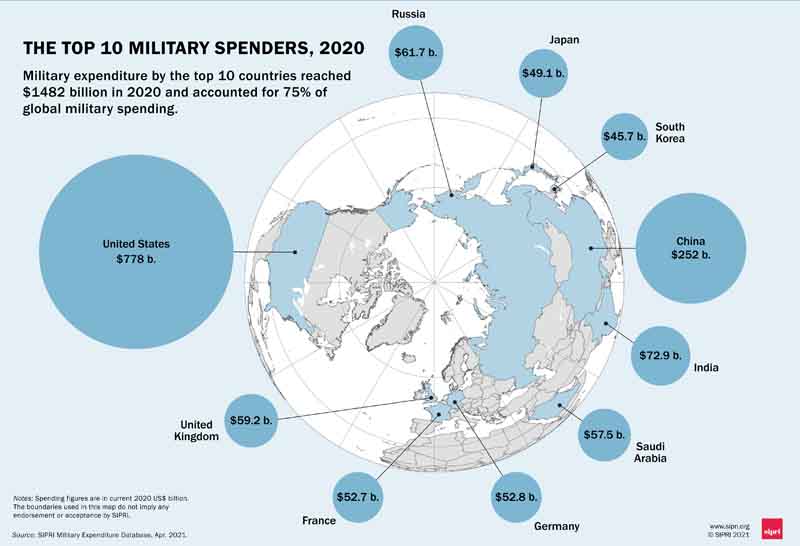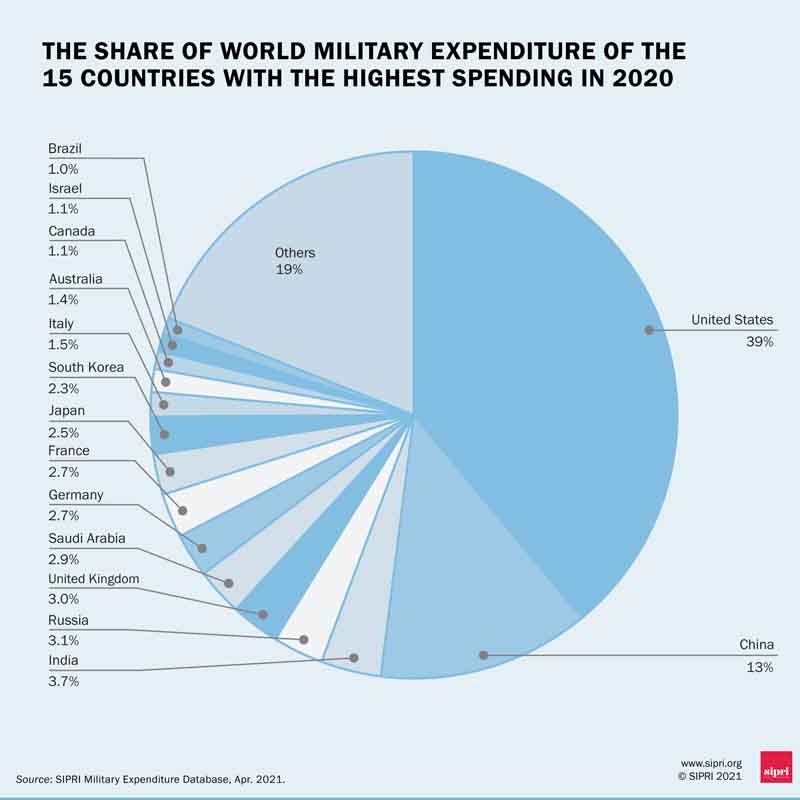- World
- Apr 30
Global military spending rises 2.6% in 2020
• Global military expenditure rose by 2.6 per cent to $1.98 trillion last year even as some defence funds were reallocated to fight the COVID-19 pandemic, the Stockholm International Peace Research Institute (SIPRI) said in a report.
• The five biggest spenders in 2020, which together accounted for 62 per cent of military spending worldwide, were the United States, China, India, Russia and Britain in that order.
• As global GDP declined because of the pandemic, military spending as a share of GDP reached a global average of 2.4 per cent in 2020, up from 2.2 per cent in 2019.
• This was the biggest year-on-year rise in the military burden since the global financial and economic crisis in 2009.
Strong increase in US military spending continues
• In 2020 US military expenditure reached an estimated $778 billion, representing an increase of 4.4 per cent over 2019.
• As the world’s largest military spender, the US accounted for 39 per cent of total military expenditure in 2020.
• This was the third consecutive year of growth in US military spending, following seven years of continuous reductions.
• The recent increases in US military spending can be primarily attributed to heavy investment in research and development, and several long-term projects such as modernising the US nuclear arsenal and large-scale arms procurement.
• This reflects growing concerns over perceived threats from strategic competitors such as China and Russia, as well as the government’s drive to bolster what it saw as a depleted US military.
China’s military expenditure rises again
• China’s military expenditure, the second highest in the world, is estimated to have totalled $252 billion in 2020.
• This represents an increase of 1.9 per cent over 2019 and 76 per cent over the decade 2011–20.
• China’s spending has risen for 26 consecutive years, the longest series of uninterrupted increases by any country in SIPRI’s database.
• China stands out as the only major spender in the world not to increase its military burden in 2020 despite increasing its military expenditure, because of its positive GDP growth last year.
• The ongoing growth in Chinese spending is due in part to the country’s long-term military modernisation and expansion plans, in line with a stated desire to catch up with other leading military powers
Other notable developments
• Even though military spending rose globally, some countries explicitly reallocated part of their planned military spending to pandemic response, such as Chile and South Korea. Several others, including Brazil and Russia, spent considerably less than their initial military budgets for 2020.
• Nearly all members of the North Atlantic Treaty Organization (NATO) saw their military burden rise in 2020. As a result, 12 NATO members spent 2 per cent or more of their GDP on their militaries, the Alliance’s guideline spending target, compared with nine members in 2019. France, for example, the eighth biggest spender globally, passed the 2 per cent threshold for the first time since 2009.
• Russia’s military expenditure increased by 2.5 per cent in 2020 to reach $61.7 billion. This was the second consecutive year of growth. Nevertheless, Russia’s actual military spending in 2020 was 6.6 per cent lower than its initial military budget, a larger shortfall than in previous years.
• With a total of $59.2 billion, the UK became the fifth largest spender in 2020. The UK’s military spending was 2.9 per cent higher than in 2019, but 4.2 per cent lower than in 2011. Germany increased its spending by 5.2 per cent to $52.8 billion, making it the seventh largest spender in 2020. Germany’s military expenditure was 28 per cent higher than in 2011. Military spending across Europe rose by 4.0 per cent in 2020.
• In addition to China, India ($72.9 billion), Japan ($49.1 billion), South Korea ($45.7 billion) and Australia ($27.5 billion) were the largest military spenders in the Asia and Oceania region. All four countries increased their military spending between 2019 and 2020 and over the decade 2011–20.
• Military expenditure in sub-Saharan Africa increased by 3.4 per cent in 2020 to reach $18.5 billion.
• Military expenditure in South America fell by 2.1 per cent to $43.5 billion in 2020. The decrease was largely due to a 3.1 per cent drop in spending by Brazil, the sub-region’s largest military spender.
• The combined military spending of the 11 Middle Eastern countries for which SIPRI has spending figures decreased by 6.5 per cent in 2020, to $143 billion.
• Eight of the nine members of the Organization of the Petroleum Exporting Countries (OPEC) for which SIPRI has figures cut their military spending in 2020.
Manorama Yearbook app is now available on Google Play Store and iOS App Store



